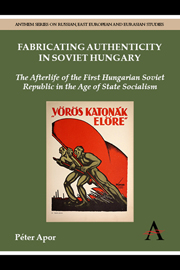 Fabricating Authenticity in Soviet Hungary
Fabricating Authenticity in Soviet Hungary Book contents
- Frontmatter
- Contents
- Acknowledgements
- List of Illustrations
- List of Abbreviations
- Introduction
- Chapter 1 Prefiguration: The First Hungarian Soviet Republic and the Rákosi Dictatorship before 1956
- Chapter 2 Resurrection: The Emergence of 1919 and the Counterrevolution after 1956
- Chapter 3 Lives: 1919 in the Postwar Trials of War Criminals
- Chapter 4 Funeral: The Birth of the Pantheon of the Labour Movement in Budapest
- Chapter 5 Narration: History, Fiction and Proof in the Representation of the First Hungarian Soviet Republic, 1959–65
- Epilogue The Agitators and the Armoured Train
- Index
- Frontmatter
- Contents
- Acknowledgements
- List of Illustrations
- List of Abbreviations
- Introduction
- Chapter 1 Prefiguration: The First Hungarian Soviet Republic and the Rákosi Dictatorship before 1956
- Chapter 2 Resurrection: The Emergence of 1919 and the Counterrevolution after 1956
- Chapter 3 Lives: 1919 in the Postwar Trials of War Criminals
- Chapter 4 Funeral: The Birth of the Pantheon of the Labour Movement in Budapest
- Chapter 5 Narration: History, Fiction and Proof in the Representation of the First Hungarian Soviet Republic, 1959–65
- Epilogue The Agitators and the Armoured Train
- Index
Summary
What makes abstract historical interpretations authentic? This theoretical question troubled Communist Party leaders and propaganda historians in Hungary during the years that followed the restoration of dictatorship after the suppression of the anti-Stalinist uprising in October–November 1956. János Kádár's government, which had been established only by the military might of the Soviet Union, attempted to obtain legitimacy on the basis of a curious historical argument. Meanwhile, the new Communist leadership justified the suppression of democratic and independent aspirations by claiming to protect Hungarians against the peril of counterrevolution. It built the image of October 1956 on its alleged historical connection with 1919 and the White Terror that followed the fall of Béla Kun's short-lived Soviet Republic. Since it was vital for Kádár and his fellow party leaders to reify the imaginary historical continuity between the ‘first’ and ‘second’ editions of the White Terror, it became crucial to construct a credible representation of the First Hungarian Soviet Republic that suited the comprehensive revision of modern Hungarian history.
The subject of this work, therefore, is the crooked history of the revisions of the First Hungarian Soviet Republic between the years of its 30th and 40th anniversaries, 1949 and 1959. This particular historical event grew from a relatively isolated detail of the self-history of the Hungarian Communist movement into the most highly praised national celebration.
- Type
- Chapter
- Information
- Fabricating Authenticity in Soviet HungaryThe Afterlife of the First Hungarian Soviet Republic in the Age of State Socialism, pp. 1 - 26Publisher: Anthem PressPrint publication year: 2014


